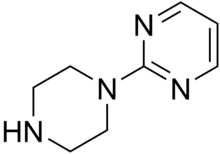Pyrimidinylpiperazine
1-(2-Pyrimidinyl)piperazine (1-PP, 1-PmP) is a chemical compound and piperazine derivative. It is known to act as an antagonist of the α2-adrenergic receptor (Ki = 7.3–40 nM)[1] and, to a much lesser extent, as a partial agonist of the 5-HT1A receptor (Ki = 414 nM; Emax = 54%).[2][3] It has negligible affinity for the dopamine D2, D3, and D4 receptors (Ki > 10,000 nM) and does not appear to have significant affinity for the α1-adrenergic receptors.[4]
 | |
| Names | |
|---|---|
| IUPAC name
2-(piperazin-1-yl)pyrimidine | |
| Identifiers | |
3D model (JSmol) |
|
| ChEMBL | |
| ChemSpider | |
| ECHA InfoCard | 100.040.107 |
PubChem CID |
|
CompTox Dashboard (EPA) |
|
| |
| |
| Properties | |
| C8H12N4 | |
| Molar mass | 164.21 g/mol |
Except where otherwise noted, data are given for materials in their standard state (at 25 °C [77 °F], 100 kPa). | |
| Infobox references | |
Derivatives
A number of pyrimidinylpiperazine derivatives are drugs, including:
- Buspirone - anxiolytic
- Dasatinib - anticancer agent
- Eptapirone - anxiolytic
- Gepirone - anxiolytic
- Ipsapirone - anxiolytic
- Piribedil - antiparkinsonian agent
- Revospirone - anxiolytic
- Tandospirone - anxiolytic
- Tirilazad - neuroprotective agent
- Umespirone - anxiolytic
- Zalospirone - anxiolytic
The anxiolytics are also classified as azapirones due to the azaspirodecanedione moiety in their structures. 1-PP is a common metabolite of most or all of the listed agents.[1][5] Alnespirone, binospirone, and enilospirone, despite being azapirones, are not piperazines and therefore do not metabolize to 1-PP, and while perospirone and tiospirone are piperazines, they are instead benzothiazole-substituted piperazines and do not metabolize to 1-PP either.
See also
References
- Blier P, Curet O, Chaput Y, de Montigny C (1991). "Tandospirone and its metabolite, 1-(2-pyrimidinyl)-piperazine--II. Effects of acute administration of 1-PP and long-term administration of tandospirone on noradrenergic neurotransmission". Neuropharmacology. 30 (7): 691–701. doi:10.1016/0028-3908(91)90176-c. PMID 1681447.
- Zuideveld KP, Rusiç-Pavletiç J, Maas HJ, Peletier LA, Van der Graaf PH, Danhof M (2002). "Pharmacokinetic-pharmacodynamic modeling of buspirone and its metabolite 1-(2-pyrimidinyl)-piperazine in rats". J. Pharmacol. Exp. Ther. 303 (3): 1130–7. doi:10.1124/jpet.102.036798. PMID 12438536.
- Gobert, A.; Newman-Tancredi, A.; Rivet, J.M.; Audinot, V.; Millan, M.J. (1997). "P.1.047 Yohimbine is a potent, partial agonist at rat and cloned, human serotonin1A receptors: A comparison to buspirone and its metabolite, 1-pyrimidinylpiperazine". European Neuropsychopharmacology. 7: S149–S150. doi:10.1016/S0924-977X(97)88496-9. ISSN 0924-977X.
- Bergman J, Roof RA, Furman CA, Conroy JL, Mello NK, Sibley DR, Skolnick P (2013). "Modification of cocaine self-administration by buspirone (buspar®): potential involvement of D3 and D4 dopamine receptors". Int. J. Neuropsychopharmacol. 16 (2): 445–58. doi:10.1017/S1461145712000661. PMC 5100812. PMID 22827916.
- Astier B, Lambás Señas L, Soulière F, Schmitt P, Urbain N, Rentero N, Bert L, Denoroy L, Renaud B, Lesourd M, Muñoz C, Chouvet G (2003). "In vivo comparison of two 5-HT1A receptors agonists alnespirone (S-20499) and buspirone on locus coeruleus neuronal activity". Eur. J. Pharmacol. 459 (1): 17–26. doi:10.1016/s0014-2999(02)02814-5. PMID 12505530.